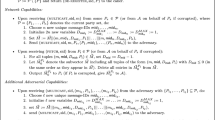Abstract
Protocols enable unambiguous, smooth interactions among agents. Commitments among agents are a powerful means of developing protocols. Commitments enable flexible execution of protocols and help agents reason about protocols and plan their actions accordingly, while at the same time providing a basis for compliance checking. Multiagent systems based on commitments can conveniently and effectively model business interactions because the autonomy and heterogeneity of agents mirrors real-world businesses. Such modeling, however, requires multiagent systems to host a rich variety of protocols that can capture the needs of different applications. We show how a commitment-based semantics provides a basis for refining and aggregating protocols. We propose an approach for designing commitment protocols wherein traditional software engineering notions such as refinement and aggregation are extended to apply to protocols. We present an algebra of protocols that can be used to compose protocols by refining and merging existing ones, and does this at a level of abstraction high enough to be useful for real-world applications.
Similar content being viewed by others
References
Andrews, T., Curbera, F., Dholakia, H., Goland, Y., Klein, J., Leymann, F., Liu, K., Roller, D., Smith, D., Thatte, S., Trickovic, I., Weerawarana, S. (2003). Business Process Execution Language for Web Services (BPEL 1.1).
Bussmann, S., Jennings, N.R., Wooldridge, M. (2003). Re-use of interaction protocols for agent-based applications. In F. Giunchiglia, J. Odell, G. Weiß (Eds.), Third international workshop on agent-oriented software engineering (AOSE 2002), Vol. 2585 of Lecture notes in computer science (pp. 73–87). Springer.
Castelfranchi, C. (1993). Commitments from individual intentions to groups and organizations. In Proceedings of the AAAI-93 workshop on AI and theories of groups and organizations: Conceptual and empirical research.
Chopra, A., Singh, M.P. (2003). Nonmonotonic commitment machines. In M.-P. Huget, F. Dignum (Eds.). Proceedings of the AAMAS workshop on agent communication languages and conversation policies.
Desai N., Mallya A.U., Chopra A.K. and Singh M.P. (2005). Interaction protocols as design abstractions for business processes. IEEE Transactions on Software Engineering, 31(12): 1015–1027
Fischer, L. (Ed.). (2004). The workflow handbook 2004. Lighthouse Point, FL: Future Strategies Inc. Compendium of standards and articles by the Workflow Management Coalition (WfMC).
Flores, R.A., Pasquier, P., Chaib-draa, B. (2006). Conversational semantics with social commitments. Journal of Autonomous Agents and Multiagent Systems, this volume.
Fornara, N., Colombetti, M. (2003). Defining interaction protocols using a commitment-based agent communication language. In Proceedings of the second international joint conference on autonomous agents and multiagent systems (AAMAS) (pp. 520–527). ACM Press.
Fornara N., Viganó F., Colombetti M. (2006). Agent communication and institutional reality. Journal of Autonomous Agents and Multiagent Systems, this volume.
Fu, X., Bultan, T., Su, J. (2004). Realizability of conversation protocols with message contents. In Proceedings of the 2004 international conference on web services (pp. 96–105). IEEE Computer Press.
Grosof, B.N., Poon, T.C. (2003). SweetDeal representing agent contracts with exceptions using XML rules, ontologies, and process descriptions. In Proceedings of the twelth international conference on the world wide web (pp. 340–349).
Hamadi, R., Benatallah, B. (2003). In Zhou, X., Schewe, K.-D. (eds.), Proceedings of the fourteenth Australian database conference. ADC, Vol.17 of conferences in research and practice in information technology (pp. 191–200). Australian Computer Society.
Johnson M.W., McBurney P. and Parsons S. (2003). When are two protocols the same?. In: Huget, M-P (eds) Communication in multiagent systems: Agent communication languages and conversation policies,Vol. 2650 of Lecture notes in artificial intelligence., pp 253–268. Springer-Verlag, Berlin
Kagal, L., Finin, T. (2006). Modelling communicative behavior using permissions and obligations. Journal of Autonomous Agents and Multiagent Systems, this volume.
Malone, T.W., Crowston, K., & Herman, G. A. (Eds.). (2003). Organizing business knowledge: The MIT process handbook. MIT Press, Cambridge, MA
Peltz C. (2003). Web service orchestration and choreography. IEEE Computer, 36(10): 46–52
Pitt, J., Mamdani, A. (2000). Communication protocols in multi-agent systems. In F. Dignum, M. Greaves (Eds.). Issues in agent communication, (pp. 160–177). Vol. 1916 of Lecture notes in artificial intelligence Springer.
Rosenberg, J., Schulzrinne, H., Camarillo, G., Johnston, A., Peterson, J., Sparks, R., Handley, M., Schooler, E. (2002). SIP: Session Initiation Protocol. IETF Proposed Standard.
Singh, M.P. (1991). Social and psychological commitments in multiagent systems. In AAAI fall symposium on knowledge and action at social and organizational levels (pp. 104–106).
Singh M.P. (1999). An ontology for commitments in multiagent systems: Toward a unification of normative concepts. Artificial Intelligence and Law, 7: 97–113
Sirbu M.A. (1997). Credits and debits on the internet. IEEE Spectrum, 34(2): 23–29
van der Aalst, W., Desel, J., & Oberwis, A. (Eds.). (2000). Business process management: Models, techniques and empirical studies Vol. 1806 of Lecture notes in computer science. Springer-Verlag, Berlin
van der Aalst, W., & van Hee, K. (Eds.). (2002). Workflow management models, methods and systems. MIT Press, Cambridge, MA
Verdicchio M. and Colombetti M. (2002). Commitments for agent-based supply chain management. ACM SIGecom Exchanges, 3(1): 13–23
Vitteau, B., Huget, M.-P. (2004). Modularity in interaction protocols. In: F. Dignum (Ed.). Advances in agent communication, (pp. 291–309). Vol. 2922 of Lecture notes in artificial intelligence Springer.
Yolum, P., Singh, M.P. (2002). Flexible protocol specification and execution: Applying event calculus planning using commitments. In Proceedings of the first international joint conference on autonomous agents and multiagent systems (AAMAS) (pp. 527–534). ACM Press.
Author information
Authors and Affiliations
Corresponding author
Additional information
We thank Amit Chopra, Nirmit Desai, and anonymous referees for valuable comments. This research was supported partially by the NSF under grant DST-0139037, and partially by DARPA under contract F30603-00-C-0178.
Rights and permissions
About this article
Cite this article
Mallya, A.U., Singh, M.P. An algebra for commitment protocols. Auton Agent Multi-Agent Syst 14, 143–163 (2007). https://doi.org/10.1007/s10458-006-7232-1
Published:
Issue Date:
DOI: https://doi.org/10.1007/s10458-006-7232-1




